PDF chapter test TRY NOW
Birds:
1. Birds have a streamlined body that is covered with feathers. The forelimbs of the birds are well-developed and modified into wings for flying.
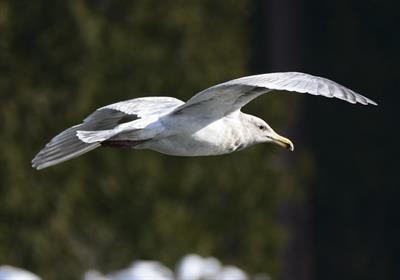
Bird
2. The body shape of the birds reduces resistance to air during flight.
3. Birds have a beak instead of a mouth. Beaks are used for eating, killing the prey, feeding the young one, etc.
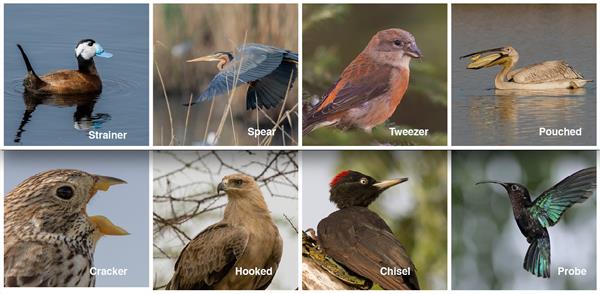
Different shapes of beaks in birds
4. Birds breathe or respire through their lungs. There is the presence of air sacs that aids in double respiration.
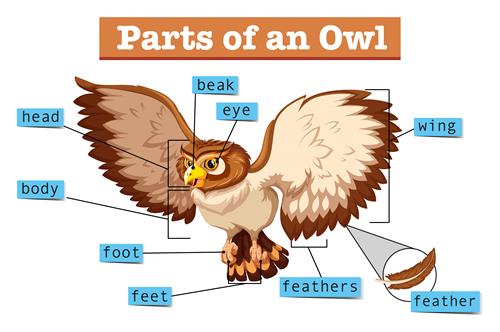
Anatomy of bird
5. They have pneumatic bones that contain air cavities and thus are hollow and light. These bones reduce the bodyweight of the birds.
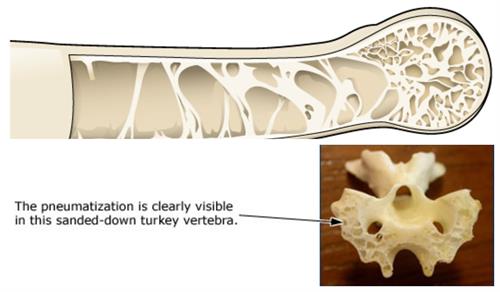
Internal structures of pneumatic bones
6. Birds can hop, run, move on the ground. They perch on the branches of the tree with the help of the paired claw feet.
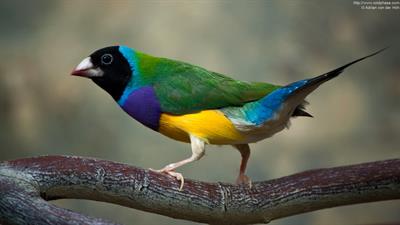
Bird perch onto the branch with the help of claws
7. Bird's tail helps in the control of direction and movements.
8. Birds have strong and well-developed chest muscles that help withstand the air pressure while flapping the wings during flight.
9. They have binocular vision - they can see one object with one eye and another object with another eye.
10. Some of the birds have webbed feet that aids in swimming.
Example:
Ducks and swans.
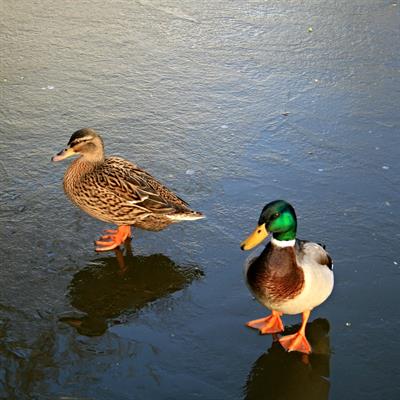
Webbed feet in ducks
11. Most birds can fly, but some of the birds cannot fly - flightless birds.
Example:
Penguins and ostrich.
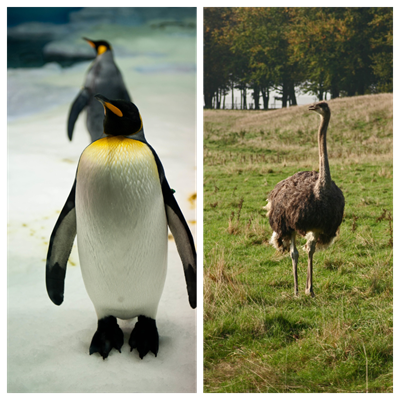
Flightless birds - Penguin & Ostrich
Migration in birds:
When an animal travels from its location to another location when the season changes, it is called Migration.
Birds travel long-distance to escape the extreme environmental condition is called migration.
To escape the extreme winter season, birds travel from other parts of the world to warmer regions like India. Birds and animals migrate to a warmer place during the unfavourable season (when the winter begins) and return when the winter is over.
Birds migrate to lay eggs and to overcome the harsh environment of the current habitat. In Tamil Nadu, bird sanctuaries are present at Vedanthagal, Kodiyakkarai, and Koondhankulam. In addition, birds from Siberia and Russia migrate to these bird sanctuaries.
Siberian cranes travel from Siberia to places like Bharatpur in Rajasthan, Sultanpur in Haryana, and other wetlands of the north-east parts of India. They travel to escape the harsh conditions and to get food. The Siberian crane can travel an average of 200 miles on a single day.
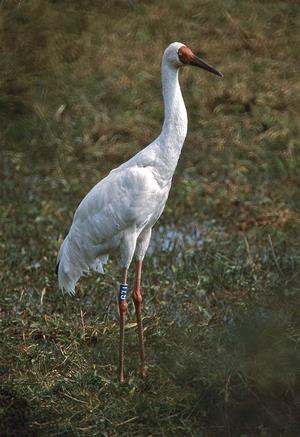
Siberian crane
During summer and drought conditions, birds from our country migrate and travel to other foreign countries. These birds are called Migratory birds.
Reference:
https://www.freepik.com/free-vector/diagram-showing-parts-owl_4970210.htm#page=1&query=bird%20diagram&position=14
https://pixabay.com/photos/siberian-crane-pond-white-wings-2510324/
https://www.flickr.com/photos/96623900@N06/14433269672/in/photolist-nZqhe7-24AfXvp-Erzxa-nH4v5x-WJ7cGC-2b3zXrm-YYtdFU-243ZWzS-nZf3Yi-SzQ7ti-21NL52S-o2jzKv-2edEWPL-SxCszs-agvUiq-nH4fnz-21LKM35-MreXqm-fbnoew-Hrd1Yj-JhFEYk-Rsui7P-R52Ygg-2e73bSt-RdEUqD-P3CqqS-np3ka5-VudwAV-RSEvoG-29EkakS-2eb426D-mzwn1J-2eTzzgv-24qUGiK-HzyvNW-DuSXyk-cASvtN-9qSH1P-8MFYiT-RSEx8d-CnA44F-bpyZSh-SoN1Go-7asx3h-e6Y2uW-Yv1te3-di6SmW-ppNg5t-JPyXHt-27kjbnn
https://www.flickr.com/photos/wall_ws/14044226202/in/photolist-np3ka5-VudwAV-RSEvoG-29EkakS-2eb426D-mzwn1J-2eTzzgv-24qUGiK-HzyvNW-DuSXyk-cASvtN-9qSH1P-8MFYiT-RSEx8d-CnA44F-bpyZSh-SoN1Go-7asx3h-e6Y2uW-Yv1te3-di6SmW-ppNg5t-JPyXHt-27kjbnn-HePS9f-28WvYGE-29gQFSg-29bSpw3-2aFLKhA-HBsuG7-Dqhncu-cn4XLy-UsJwvi-27798xg-21z3uim-226jDKJ-24sjSEi-YJisd9-qNmaDk-28LmLkm-2dyohfo-214zqdM-CUBafv-RSEvRf-heFC3G-2eHPB5d-Lc54AN-26tWqWQ-RSEwzQ-9PBVje
https://www.flickr.com/photos/sdaly/49247714681/in/photolist-2i2RpNZ-2kYKtoF-2jLob24-2hiETQW-2kWWqrX-2keKqgb-2k9gDKt-RW2skp-2jMbJQh-2jrXrke-SDoVSD-EpHrs6-2kGiK1X-2ktq2z8-2kUuQkR-2jsgLyG-2jtiUNQ-2ky6mRE-2kSL4sp-2jKWT97-qPRjMQ-2iMvk25-2kybJWr-2gx2CbM-2kVB4Gj-URxwKG-2kR7q9f-2kZbGRv-2jcKCLb-2jcrJok-2kRGemD-2kwfrnb-GwJLDQ-2ijg8u8-24U4jAe-2kP54er-2kRvJ9j-28jT9GE-2kSC5Dq-2jRyVX1-2kUfmLH-2jFxvCV-LJQv6j-2jGyQJZ-2kf6Gnj-XJnFGc-is6pZz-2hFp4dz-2kkVKc6-SKpmsc
https://www.flickr.com/photos/lordskully/24691032606/in/photolist-DBRZLJ-2ctSMy2-JEGhj8-27Ucxsy-23Bt4GM-GNB94f-26VZo3g-2aE5b6v-JiouVn-27yVaXB-261vRvc-2evwq2B-MAEwfs-28QFqC2-2duochG-25aaGj1-DEemDd-ZGzrQ7-27LkNP9-N6aPdu-nPLZyT-P4EFB2-VdZimK-23UCBfg-GNB8Cf-wQUZoy-Fsz4DF-HsqsvP-FLDAiT-2aDuQDU-29ZEmoK-28ykThj-WLAMKo-HgeDPk-23NpCs2-7zJRX3-24S1xiX-2cKsQEW-J8Lbgz-QhPab9-25XYu7p-2evFwMX-KB4pSX-27vZjtW-QmyTFV-HsqtvV-YXLDVK-2aEbxKz-VPpwyt-Tic8Cu
https://www.flickr.com/photos/ruthanddave/53085910/in/photolist-5G5Aj-6nDyoz-bSC6sT-bqps98-6XZTqE-zxW6ti-75ykP7-6TvDLX-rgg1b1-orUg9f-3Et2xd-75ykRW-akkfDa-c93SiY-6EVgBj-4QmKDp-bCPtxZ-5Mntez-4HCtWZ-aR4CKD-bnpodX-KCgCMY-nqH5wF-JF7BH-4nh8Y-3usx6g-HuCnf-pCkfTY-mToJPv-66YEka-7YwSXL-59nS9h-54dbSe-8hU6sa-cBmpfq-8TrPTf-c5tJ71-caLUFj-DAc2CB-9fvJ2-529ZaM-a3L77X-7XS71D-964qgK-8oHnZY-nhw1-6o2aV9-7c1VHz-KCh5Go-phpEqg
https://www.flickr.com/photos/tb9900/5406836626/in/photolist-9eMsa9-5LTQZ-7fDQQD-dQo9cg-8bVTXj-a967s4-a3AgqS-9FQKK4-a9fVtS-egZT7j-9FVwVv-e6iAa5-aWYD8t-8ghGb8-4Wmfs7-axVke4-aqJbzQ-8gkY4N-ECUv3-cK25XU-5zn98y-6DjVT7-oFbyW6-8m3AzK-2FB67q-drcdfc-7k4tin-xaYkn8-aPu6sZ-8sZJe2-5zka5x-8xeGHy-7fDQy8-6Df6aD-cK22Uj-om63XP-3CYy9-d6bSB-9u5V7W-8ssemx-7tsrj2-5oaVNN-9DE44w-8xRqSc-9mfDue-9miHZm-m1uKg-9mfCeK-gi3oL-61dWCY/
https://commons.wikimedia.org/wiki/File:Siberian_Crane_(Grus_leucogeranus)_(20595154208).jpg
https://courses.lumenlearning.com/wmopen-biology2/chapter/birds/
